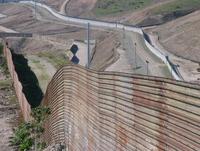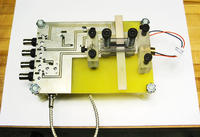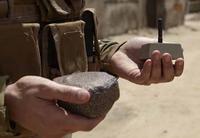-
Discovery Channel special on protecting U.S. northern border
The Discovery Channel on Wednesday aired a documentary on DHS, called “Under Siege: America’s Northern Border.” The show will be shown several more times in the coming weeks. The one-hour special focuses on the northern border of the United States, which was a crossing point for some of the terrorists behind the first World Trade Center attack.
-
-
Our primary border security system cannot distinguish between a cow and a terrorist
One of the main security components along the U.S.-Mexico border is a system of 12,000 aging ground sensors. These sensors, however, cannot distinguish between human beings trying to cross the border, a grazing cow, or a pack of javelin – the wild boar that roams this area along the Rio Grande. DHS has so far spent billions on trying to find a technology which would better secure the border. The question that should be asked is why DHS has not adopted a proven system of sophisticated ground sensors, like the one which the U.S. Army has successfully deployed in Iraq and Afghanistan.
-
-
Problems-plagued border sensor program put on hold by CBP
Two years ago, DHS cancelled SBInet, the ambitious Bush-era project to install advanced sensing technology along the border. The project was cancelled after more than $1 billion were spent on a few towers equipped with sensors which were built along a 28-mile stretch and the Arizona-Mexico border. Now CBP has put on hold one of SBInet’s successors, a project aiming to install sophisticated ground sensors along the U.S.-Mexico border.
-
-
DHS secretary says El Paso border is secure

During a visit to El Paso, Texas on Tuesday, DHS secretary Janet Napolitano highlighted improvements in border security, as many in Congress argue that the path to immigration reform begins with making sure the U.S.-Mexico border is secure.
-
-
Portable X-ray source offers a mobile terrorism prevention tool

The hand-held scanners, or tricorders, of the Star Trek movies and television series are one step closer to reality now that a engineers have invented a compact source of X-rays and other forms of radiation; the radiation source, which is the size of a stick of gum, could be used to create inexpensive and portable X-ray scanners for use by doctors, as well as to fight terrorism and smuggling and aid exploration on this planet and others
-
-
U.S. cuts budget for nuclear monitoring at foreign ports
In 2003 the United States decided to install radiation detection equipment in 100 large ports around the world, and train local personnel in using the equipment, so that ship containers could be scanned for nuclear material before the ship left for the United States; so far, equipment has been deployed in forty-two ports; after GAO criticism of the quality of the scanning equipment and of lack of coordination between two similar container scanning programs, the National Nuclear Security Administration’s 2013 budget will be cut by 85 percent, and further installations will be canceled
-
-
Detecting tunnels -- used to smuggle drugs, weapons, or people – is not easy
It seems reasonable to assume that it would be easy to use seismic waves to find tunnels dug by smugglers of drugs, weapons, or people, but this assumption is wrong; scientists are trying to get a better look at the ground around tunnels to learn why seismic data finds some tunnels but not others – and come up with a seismic detection process for the border and other areas where tunnels pose a security threat
-
-
CBP wants more drones, but lawmakers want more details about their use
The U.S. Customs and Border Protection (CBP) wants to have a fleet of twenty-four drones to patrol the northern and southern borders of the United States, but Congress has yet to appropriate funding beyond the first ten drones; so far in 2012, drones have been credited with leading to more arrests and drug seizures than ever before, but their contribution is still small
-
-
Border Patrol relies in obsolescent surveillance gear
An Obama administration plan to update equipment the Border Patrol is using did not materialize, and now officials are concerned about outdated equipment putting the lives of agents in danger; the sensors now in use were originally said to be able to put Border Patrol agents in position to capture 90 percent of border invaders, but the DHS inspector general determined that just 4 percent of the alarms were confirmed cases of smugglers and border crossers; 34 percent were false alarms, and 62 percent were undetermined
-
-
U.S. testing blimps, surveillance towers on Mexican border
Last year, the U.S. government ended SBInet, a major and unsuccessful attempt to build a virtual fence along the border that cost nearly $1 billion before it was killed; DHS is now testing aerostats, and an 80-foot tower with similar surveillance capabilities, for border security as part of an effort to exploit technologies that have been used in the wars in Iraq and Afghanistan
-
-
Border Patrol kiosk detects liars trying to enter U.S.

The U.S. Customs and Border Protection (CBP) is using border crossing stations in Arizona to test new technology to detect liars as they attempt to enter the country; travelers are subjected to a 5-minute interview with the kiosk, while microphones monitor vocal pitch frequency and quality, an infrared camera monitors eye movement and pupil dilation, and a high definition camera monitors facial expression
-
-
Concerns over terrorist groups gaining foothold in Latin America
At the moment, Islamic militant and terrorist groups do not seem to have a presence in Latin America, but concerns are growing that these groups could develop strategic links with drug organizations, posing a serious threat to security in the hemisphere
-
-
Underground spies to secure Indo-Pakistan border

With the discovery of a 400-foot long tunnel at the India-Pakistan Border, the IndianHome Ministry has decided to acquire Unattended Ground Sensors (UGS) that could be installed along the international border with Pakistan as an important line of defense
-
-
Two companies offer tower-based border security systems
General Dynamics C4 Systems and EADS North America have joined forces to develop border protection and security systems which exploit the both companies’ strength; the team offers tower-based, integrated radar and sensor systems for an “always-on, ever-aware” picture of human activity in and around national borders
-
-
Biometrics proves 1 percent of applicants to enter U.S. are unsuitable
Chris Archer, the online content editor at IDGA (the Institute for Defense & Government Advancement), talked with James Loudermilk, Senior Level Technologist, FBI Science and Technology Branch, about biometrics and biometrics and homeland security; Loudermilk says that biometrics applications helped the FBI determine that about 1 percent of people who seek visa to visit the United States as tourists have previously done things that make them unsuitable guests; the conversation examines the application of biometrics for homeland security, issues relating to privacy and civil liberties, and what can be learned from international biometrics projects, including India’s UID scheme
-
- All
- Regional
- Water
- Biometrics
- Borders/Immig
- Business
- Cybersecurity
- Detection
- Disasters
- Government
- Infrastructure
- International
- Public health
- Public Safety
- Communication interoperabillity
- Emergency services
- Emergency medical services
- Fire
- First response
- IEDs
- Law Enforcement
- Law Enforcement Technology
- Military technology
- Nonlethal weapons
- Nuclear weapons
- Personal protection equipment
- Police
- Notification /alert systems
- Situational awareness
- Weapons systems
- Sci-Tech
- Sector Reports
- Surveillance
- Transportation
Advertising & Marketing: advertise@newswirepubs.com
Editorial: editor@newswirepubs.com
General: info@newswirepubs.com
2010-2011 © News Wire Publications, LLC News Wire Publications, LLC
220 Old Country Road | Suite 200 | Mineola | New York | 11501
Permissions and Policies
Editorial: editor@newswirepubs.com
General: info@newswirepubs.com
2010-2011 © News Wire Publications, LLC News Wire Publications, LLC
220 Old Country Road | Suite 200 | Mineola | New York | 11501
Permissions and Policies
